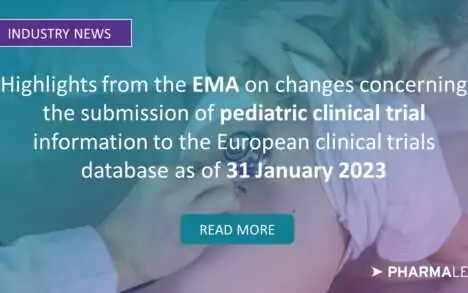Children are not just “little adults” when it comes to drug development. That is made clear in both the European Community amended regulation[i] and the US Pediatric Research Equity Act (PREA)[ii].
Child-focused regulation was an attempt by the European Medicines Agency (EMA) and Food and Drug Administration (FDA) to address “off label” unlicensed use of drugs, licensed in adults, to treat children. This practice involved using lower doses or on a less frequent basis, with unsuitable dosage forms, such as difficult to swallow tablets rather than suitable licensed liquid formulations[iii].
Today, however, the legislation assures the timely study of new drugs in children in parallel to their development in adults. It also confirms a requirement that sponsors must develop a drug for an indication other than the one they are seeking approval for if the Paediatric Committee (PDCO) deems it has the potential to address an unmet medical need in children, based on its mechanism of action. Today every drug developer must integrate Chemistry Manufacturing and Controls (CMC), non-clinical, clinical and condition-specific data together to design a coherent pediatric development strategy to give children early access to life-changing medicines[iv]. This is especially true for cell and gene therapies (CGT) that provide corrections to gene mutations where early correction of the defect can avoid long-term complications from their disease[v].
The goals of US and EU pediatric legislation are similar, in that all CMC, non-clinical and clinical data are assessed for their suitability and applicability for use in a pediatric population. In the EU this assessment is captured in a Paediatric Investigation Plan (PIP)[vi], while in the US it is covered in the Initial Pediatric Study Plan (iPSP)[vii].
Some elements within these documents apply to both the iPSP and PIP. For example, both require a sponsor to propose either a total development plan or a partial plan that includes age-specific waivers for some age groups based on either lack of safety or efficacy, the condition not occurring in the age subset, a lack of therapeutic benefit or condition-specific grounds.
It is also possible to defer providing data until after regulatory approval in adults where there are major development gaps that need to be generated before the drug is used in an age-sensitive population. This includes gaps in toxicology or clinical data or due to formulation-specific changes.
The timing for a PIP submission in Europe is when the Phase 2 dose is selected at the end of Phase 1 (EOP1). In the US, the timing is a little later, with an iPSP required to be submitted within 60 days after the end of phase 2 (EOP2) meeting. Occasionally for CGT, if the disease exclusively affects children, a PIP can be in place right from the start of development and the discussions with EMA’s PDCO assist in managing expectations about study outlines, endpoints, formulation development and other issues. The sponsor should always consider when pediatric patients should enter into the development program (such as pivotal phase 2 or 3) and ensure that those pediatric considerations are in place well before their participation in clinical trials. Importantly, when a Marketing Authorization Application (MAA) or New Drug/Biologics License Application (NDA/BLA) is submitted to EMA / FDA respectively (with the exception of orphan medicines and interchangeable biosimilars in the US), it is mandatory for the PIP/iPSP to be pre-agreed with the regulatory authorities. These are assessed for their compliance at the time of filing for later attribution of the pediatric incentives in the form of marketing exclusivity.
The United Kingdom’s exit from the EU has led to the Medicines and Healthcare products Regulatory Agency (MHRA) making independent regulatory decisions. The recent introduction of an international recognition procedure to debut in 2024 means that a sponsor will need to consider whether the US or EU dossier will serve as the reference dossier for the UK MAA, which means what is agreed in the iPSP/PIP will need to be considered carefully when assessing the UK PIP and global filing strategy[viii]. That applies to the timing of the PIP/iPSP submission and its content – the indication, the grounds for waivers and deferrals, as well as age subsets.
With these considerations in mind, there are several approaches for achieving a global PIP strategy, including informal and formal mechanisms, country-first and parallel scientific advice.
Approach 1 : Apply for a pediatric cluster discussion
An international collaboration consisting of a monthly pediatric cluster meeting is held between EMA and FDA with the Japanese Pharmaceuticals and Medicinal Devices Agency (PDMA), Health Canada and the Australian Therapeutic Goods Administration (TGA) attending as active participants. The cluster meeting provides a forum for these agencies to communicate and collaborate on pediatric development of new chemical entities, biologics and gene therapies[ix].
The goal of the pediatric cluster meetings is to ensure that all pediatric studies are conducted in a scientifically rigorous and ethical manner and to avoid duplicative and unnecessary trials. FDA/EMA may decide to add a project for discussion at the cluster meeting, alternatively the sponsor may ask for a project to be added to the agenda. If the latter is the case, the sponsor provides documentation (in the form of pediatric development plans) to the agencies to assess and provide informal comments. Typically, the cluster discussion occurs at EU Day 60 of the EU PIP process. The output from this meeting is the “Common Commentary Document” which may be delivered during the EU Day 60 PIP clock-stop of the procedure, or later if multiple discussions are required.
The common commentary produced by EMA/FDA is non-binding and is not considered regulatory advice. A sponsor is not invited to participate at the cluster meeting, so there is no possibility for the debate of development issues. There may still be legislative and procedural differences between the EU and US regions (such as pediatric age group subsets) and accommodating these differences for development is not always achievable.
Approach 2: File the EU PIP first
The next approach is to file the EU PIP first and then try to align the US iPSP with what is agreed, since the EU outcome may be included in Section 12 of the iPSP (Agreements for Pediatric Studies with Other Regulatory Authorities) for FDA consideration. Our general experience is the threshold for a PIP, and the time required to have a PIP in place in the EU, is much longer than the corresponding procedure for an iPSP.
One advantage of going to the EU first and working closely with EMA is that pediatric scientific advice prior to submitting a PIP is free. Furthermore, the PDCO has close affiliations with a network of European experts and centers specialized in pediatric development through the European Network of Paediatric Research (Enpr) at the EMA who can partner with sponsors lacking in pediatric expertise to help tailor the design of pediatric trials[x].
One important point is that the condition in the EU PIP must correspond to a Medical Dictionary for Regulatory Activities (MedDRA) Higher Level Term (HLT) for the adult condition. As such, the PIP condition may result in a broader scope/indication than the developer initially desires.
In contrast, the FDA will only consider the proposed indication and the orphan status of the drug which grants the developer an exemption from pediatric development under the PREA. The iPSP for an orphan drug in the US can later be modified to include the pediatric studies required by the EU. Oncology indications are covered by the FDA Reauthorization Act of 2017, which means that, just like in the EU, the mechanistic relevance of a molecular target for pediatric cancer development must be considered[xi]. This overrules PREA requirements; for example, monoclonal antibodies targeting the EGF receptor (EGFR) for use in treatment of breast, intestinal and head and neck cancers have a class waiver in the EU, but in the US, EGFR-targeted agents remain on the molecular target list for gliomas and osteosarcoma. So, in this case, all relevant tumor types must be considered in the iPSP, based on the drug’s mechanism of action regardless of the relevant HLT and the developer’s commercial focus, though here too the possibility for PREA waivers and deferrals exists.
These regional differences in the PIP/iPSPs’ focus must be considered as early as possible, and developers must fully justify, on strong scientific and medical grounds, the position taken regarding the scope of the PIP and iPSP.
Approach 3: File the US iPSP first
As a third option, a sponsor may decide to start with the US. In the US, a sponsor that is planning to submit a licensing application (BLA/NDA) or add a supplement to an application for a new active ingredient, new indication, new dosage form, new dosing regimen, or new route of administration must submit their iPSP within 60 days after their EOP2 meeting or such other time as agreed upon between FDA and the sponsor, unless the molecule is exempt, for example, because it is an orphan drug.
By comparison, the FDA’s list of waived conditions is more extensive and solely condition-based when compared to the EU class waiver list. In addition to the EU waiver categories, an FDA waiver can be granted if pediatric clinical studies are deemed impossible or highly impractical, the medicinal product is unlikely to be used by a substantial number of pediatric patients, or if the development of a pediatric formulation has failed. The content of an initial iPSP may be discussed under a Type C meeting or, in the case of oncology products, a Pediatric Oncology Product Development Early Advice Meeting (Type F)1 with the FDA[xii].
Often, experience shows that a US drug developer will focus on drug development in the US and not consider the implications for their PIP until the EOP2. This is considered late for an EU PIP submission and can complicate European drug development. This is especially true if EU regulators do not align with US regulators on the need for juvenile toxicity studies, age group subsets, or other aspects of the design of the clinical program. A worst-case scenario is that this may lead to additional clinical studies being required, which can cause substantial delays in the regulatory approval of the drug in Europe.
To mitigate this US-centric approach, free pediatric scientific advice may be sought from EMA and the outcome of the advice included as part of the initial iPSP to allow for US regulators to understand the European regulators approach to drug development for pediatric patients.
Approach 4: Parallel scientific advice
Since 2005, a Parallel Scientific Advice (PSA) program has been available for EMA/FDA and sponsors to collaborate on important medicinal products that meet the qualification criteria. The goal is to increase regulatory dialogue from the beginning of the lifecycle of a new product to foster a deeper understanding of regulatory decision-making, to optimize product development and to avoid unnecessary clinical testing[xiii]. This underutilized regulatory route receives 5 to 7 requests for a meeting per year. However, pediatric development plans are aligned with the goals of the PSA which could be used to help define global pediatric development strategies for products meeting entry criteria.
To request PSA, a sponsor sends an email outlining the rationale, the proposed scientific questions and desired goals for the PSA meeting simultaneously to both EMA and FDA. The acceptance of this request is based on merit, and meetings are reserved for medicinal products being developed for indications where there is no development guidance, or where EMA’s and FDA’s guidelines diverge considerably. Upon acceptance of the request, the sponsor submits their briefing package according to the published EMA’s scientific advice schedule.
EMA and FDA will hold their bilateral meeting approximately 35 days after validation of the formal submission. Preliminary feedback from each agency is shared with the sponsor in writing with the goal being alignment. At this stage, preliminary responses to the sponsor’s questions or requests for the sponsor to clarify or expand a concept or proposed pathway are issued. Approximately 65 days after validation, a trilateral meeting with the sponsor, EMA and FDA is held. Written advice from each agency to the sponsor follows this meeting — from EMA within 10 days and within 30 days from FDA.
This procedure has the benefit that the sponsor can actively participate in the discussion, unlike the cluster meeting discussed earlier.
Finding the right way forward
To conclude, there are several mechanisms a developer can use to seek global regulatory alignment for drug development in children. All of them require “global thinking” to produce a robust and realistic pediatric development program. A global development strategy for a new drug must consider the implications for children early in the development plan. The pediatric strategy needs to consider regulatory precedence for the target in the region(s), the condition sought, subsequent indications for development, the age of onset of the disease in relation to pediatric subsets, whether the drug formulation is adapted for use in children, whether there is a need for juvenile animal studies, and lastly the overall clinical development strategy. These items require significant input from CMC, nonclinical, and clinical experts, as well as EU/US key opinion leaders.
A well-defined plan and tight collaboration between the team of experts will ensure that the pediatric development strategy is fit-for-purpose, feasible and able to be executed under the proposed timelines. Sponsors should not underestimate the time and resources needed for preparation of the regulatory strategy and the writing task. A coherent narrative running through the PIP/iPSP will ensure a successful PIP/iPSP application that will be well received by regulators and avoid later time-consuming and expensive modifications.
About the authors:
Emma Ungstrup is a Director of Development Consulting and Scientific Affairs at Biopharma Excellence by Pharmalex. She is a seasoned global regulatory affairs executive, with deep experience in integrated drug development strategies – particularly in diverse ATMPs (in vivo and ex vivo gene therapy, CAR-T, cellular therapy) and diverse biologics such as recombinant proteins, and monoclonal antibodies. She specializes in the effective alignment of strategy, portfolio, program and project activity.
Daina Vanags, Ph.D., is Principal Consultant, Senior Director at Biopharma Excellence and Head of Development Consulting and Scientific Affairs at PharmaLex, and is a member of the Strategic and Scientific Consulting Advisory Board. She has more than 18 years of commercial experience spanning scientific research, product development and executive management in the biotechnology industry.
[i] Commission of the European Communities Regulation (EC) No 1901/2006 on medicinal products for paediatric use and amending Regulation (EC) No 1768/92, Directive 2001/20/EC, Directive 2001/83/EC and Regulation (EC) No 726/2004. Official Journal of the European Communities L378 27/12/ 20061–19.. https://eur-lex.europa.eu/legal-content/EN/TXT/?uri=celex%3A32006R1901
[ii] Pediatric Research Equity Act | PREA, FDA. https://www.fda.gov/drugs/development-resources/pediatric-research-equity-act-prea
[iii] The EU’s new paediatric medicines legislation: serving children’s needs? Arch Dis Child 92(9):808-811, doi: 10.1136/adc.2006.105692. https://adc.bmj.com/content/92/9/808.abstract
[iv] Preparedness of medicines’ clinical trials in paediatrics, Enpr-EMA, Aug 2020. https://www.ema.europa.eu/en/documents/other/preparedness-medicines-clinical-trials-paediatrics-recommendations-enpr-ema-working-group-trial_en.pdf
[v] Considerations for the Design of Early-Phase Clinical Trials of Cellular and Gene Therapy Products, FDA, June 2015. https://www.fda.gov/media/106369/download
[vi] Paediatric investigation plans, EMA. https://www.ema.europa.eu/en/human-regulatory/research-development/paediatric-medicines/paediatric-investigation-plans
[vii] Pediatric Study Plans: Content of and Process for Submitting Initial Pediatric Study Plans and Amended Initial Pediatric Study Plans, FDA, July 2020. https://www.fda.gov/regulatory-information/search-fda-guidance-documents/pediatric-study-plans-content-and-process-submitting-initial-pediatric-study-plans-and-amended
[viii] Procedures for UK Paediatric Investigation Plan (PIPs), MHRA, Dec 2020. https://www.gov.uk/guidance/procedures-for-uk-paediatric-investigation-plan-pips
[ix] International Collaboration / Pediatric Cluster, FDA. https://www.fda.gov/science-research/pediatrics/international-collaboration-pediatric-cluster
[x] European Network of Paediatric Research at the European Medicines Agency (Enpr-EMA). European Network of Paediatric Research at the European Medicines Agency (Enpr-EMA)
[xi] Pediatric Drug Development: Regulatory Considerations — Complying With the Pediatric Research Equity Act and Qualifying for Pediatric Exclusivity Under the Best Pharmaceuticals for Children Act Guidance for Industry, FDA, May 2023. https://www.fda.gov/media/168201/download
[xii] Pediatric Oncology Product Development Early Advice Meeting (Type F)1, FDA. https://www.fda.gov/about-fda/oncology-center-excellence/pediatric-oncology-product-development-early-advice-meeting-type-f1
[xiii] EMA-FDA Parallel Scientific Advice: Optimizing Development of Medicines in the Global Age, Ther Innov Regul Sci., 2023. https://www.ncbi.nlm.nih.gov/pmc/articles/PMC9985489/








